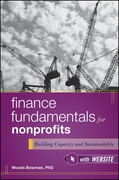
Finance fundamentals for nonprofits: building capacity and sustainability
Bowman, Woods
A complete guide to the financial requirements a nonprofit organization must follow to indefinitely maintain the volume and quality of their services An organization may have plenty of capacity in the long run, but in the short run, donor restrictions and limited financing options are constraining. Here-and-now liquid assets are the only resources available. Finance Fundamentals for Nonprofits: Building Capacity and Sustainability shows how to measure a nonprofitorganization's financial capacity in different time frames and how to measureits ability to sustain capacity in each case. Explains how nonprofits differ from businesses and how they promote values-centered management Reveals how toimprove financial capacity and sustainability Written by a nonprofit scholar Filled with real-world case studies and actionable advice relating financial health to financial capacity and sustainability, this book is essential readingfor every nonprofit professional. INDICE: Preface. Acknowledgments. Chapter 1 Introduction How Nonprofits Are (and Are Not) Like Businesses. What Are Nonprofits? Why Are There Nonprofits? Nonprofits as Businesses. This Book's Agenda. Concluding Thoughts. Chapter 2Accounting Measuring Past Performance. Basis of Accounting. Statement of Financial Position. Statement of Activities. Other Statements. Financial Statements and IRS Form 990 Compared. Concluding Thoughts. Chapter 3 Investing Looking to the Future. Investing. Endowment. Values-Centered Investing. Concluding Thoughts. Chapter 4 Budgeting Taking Control of the Present. Budgeting Practices.Budget Structure. Reconciling Budgets and Financial Statements. Reconciling Budgets and IRS Form 990. Concluding Thoughts. Chapter 5 Nonprofits in History and Tax Law. Why Nonprofits Do What They Do. Classification. Unrelated Business Tax. Intermediate Sanctions. Lobbying and Political Action. Concluding Thoughts. Chapter 6 Ordinary Service Providers. Serving the Public Today. Long TermObjective: Maintaining Services. Short Term Objective: Resilience. Current Objective: Paying Bills. Application. Benchmarking. Concluding Thoughts. Chapter7 Membership Associations. Serving People with a Common Purpose. Membership Associations. Cooperatives. Capacity and Sustainability. Two Applications. Concluding Thoughts. Appendix 7-A: ASAE/CAL Metrics of Financial Capacity for Membership Associations. Chapter 8 Endowed Service Providers. Serving the Next Generation Too. Introduction. Long Term Objective: Maintaining Services. Short Term Objective: Resilience. Current Objective: Paying Bills. Application: FamousUniversity. Building Endowment. Concluding Thoughts. Chapter 9 Grantmaking Organizations. Serving Service Providers. Foundation Types. Financing Models. Capacity and Sustainability. Illustrations. Concluding Thoughts. Appendix 9.A: S&P Metrics of Financial Capacity for Grantmakers. Chapter 10 Beyond Sustainability. Managing Revenue to Maximize Growth. Revenue Sources. Application. Unfair Competition. Concluding Thoughts. Chapter 11 The Nonprofit Difference. DoingGood Well. Control Environment. Doing Good Well. Concluding Thoughts. Notes. Glossary. References. About the Author. Index.
- ISBN: 978-1-1180-0451-7
- Editorial: John Wiley & Sons
- Encuadernacion: Cartoné
- Páginas: 224
- Fecha Publicación: 20/07/2011
- Nº Volúmenes: 1
- Idioma: Inglés
